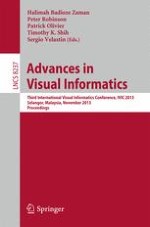2013 | Buch
Advances in Visual Informatics
Third International Visual Informatics Conference, IVIC 2013, Selangor, Malaysia, November 13-15, 2013. Proceedings
herausgegeben von: Halimah Badioze Zaman, Peter Robinson, Patrick Olivier, Timothy K. Shih, Sergio Velastin
Verlag: Springer International Publishing
Buchreihe : Lecture Notes in Computer Science
